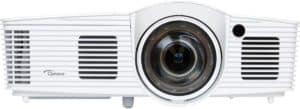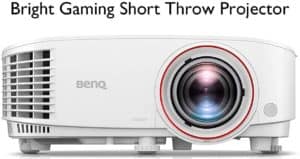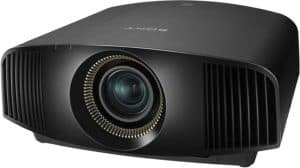Best Projector for Gaming in 2023
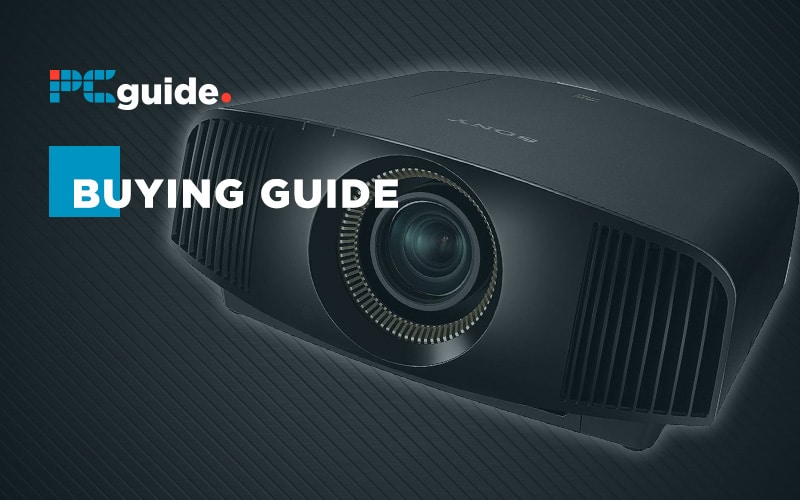
Table of Contents
Gaming on the big screen is always a delight, maximizing immersion and making you feel like you’re a part of the created 3D world. However, gaming on a projector is a whole other level, furthering those aforementioned points while also giving off a cinema-like experience when you sit down and play story-driven titles.
Products at a Glance
How we picked
We’ve scoured the market from the best projector for gaming, coming back with a selection of five top tier products that do the job and do it well. When narrowing down the array of projectors out there, we focused on some key criteria; resolution, brightness, projection size, and input lag. We believe the best projector for gaming has to excel in pretty much all of those points and we certainly have a few contenders.
Product Reviews
- Great value
- Input lag reduction
- Short-throw lens
- Limited to 1080p
A budget projector for gaming, you might think, would be lackluster in terms of brightness and picture quality. However, as components are becoming more affordable, the manufacturers in the projecting industry for years have been able to create projectors that are great for home cinemas and in this case, gaming.
Optoma is one of said companies that have been producing top projectors for years and with their GT1080 Darbee, they’ve created a budget projector that has some really impressive features. You’ll receive DarbeeVision image-enhancement technology which enables greater detail in textures and reflective surfaces, essential in today’s gaming environments with an array of game worlds and environmental elements. Further enhancing its gaming capabilities is the enhanced gaming mode which creates lightning-fast response times of 16ms, impressive for any normal display never mind a projector.
Looking deeper at the specs we can see that you will be able to make the most of the 3,000 lumens and 28000:1 contrast ratio on up to a 120-inch screen, creating a bright and vivid image for a cinema-like gaming experience. This projector can provide that 120-inch full HD picture from just 4 feet away due to the short-throw lens, meaning you won’t need a huge room to get the most out of this device.
All in all this budget projector for gaming is a brilliant choice for you price-conscious individuals. It has impressive brightness and contrast ratio as well as that short-throw lens allowing you to have a huge screen while not compromising a lot of space. Additionally, with Optoma being known for its high-quality projectors, you’re getting a device from a brand you can trust.
- Great color accuracy
- Input lag reduction
- Short-view lens
- Limited to 1080p
BenQ, known for its impressive array of displays, has built a projector for gaming that really sets itself apart from the rest. It has native full HD resolution capacity as well as 92% color accuracy, higher than most others in this price range. Additionally, you’ll receive a 3000 Lumen brightness as well as a high native contrast ratio for immersive gaming experiences. It’s not just for gaming though and can be used to play your favorite shows or films, creating a cinematic experience at home. Looking further at the tailored gaming features, it also sports ultra-fast low input lag and microsecond DMD response to ensure smooth gaming experiences without motion blur.
Again, like the aforementioned Optoma GT1080 Darbee, it has a short-throw lens, allowing you to have up to a 100-inch display from just 5 feet away, making it a great choice for those with limited space.
Overall, it’s clear to see why this won the best gaming projector in 2019, it’s pretty low cost while delivering the image quality of a much more expensive product. The gaming tailored features are similarly stellar, with low input lag as well as the short-throw lens make playing games on this projector similar, if not the same as on a monitor.
- Incredibly sharp image
- Input lag reduction
- 4k resolution
- HDR & Motionflow technology
- Expensive
Moving up to a higher resolution projector, like monitors and TVs, will provide you with a much crisper image overall and improve your overall viewing no matter what you’re using it for. Sony is at the top of the game when it comes to developing higher-end tech and their 4k projectors are no different. This variant in particular details some serious specs and the build quality of a projector you’d see in your cinema.
Of course, you’re receiving that 4k resolution of 4096 x 2160, but its the tech and features Sony has built into this projector that really makes it great for gaming. The three SXRD imagers provide full-color brightness making the hues vibrant and almost pop when playing your favorite gaming titles. Additionally, with the inclusion of HDR and Motionflow technology, there’s no screen tearing, allowing for smooth motion, especially important in twitch shooters and fast-paced games. The contrast ratio is some of the best around coming in at 350,000:1 almost 30 times that of most 1080p variants, further enhancing those already vibrant colors.
Looking at the inclusion of gaming-related features, we can see that Sony has slotted in input lag reduction which is fantastic as you’re able to fully enjoy that 4k resolution while not having to worry that your button presses are lagging behind what you’re viewing.
What else can we say really about this 4k projector for gaming? It’s a real beast and best in class in its field. It has probably one of the best image outputs on the market and with that in-built tech and input lag reduction, you can certainly get fully immersed in the games you’ll be playing on this thing. Naturally, you’ll be paying a massive premium due to the Sony brand and the quality of projector you’re getting but its certainly worth it if you want to see 4k in all its glory.
- Great value for 4k
- HDR10 technology
- Dynamic Black technology
- No input lag technology
Do budget and 4k go together when talking about projectors for gaming? Not all the time but again Optoma has pulled it out the bag with the UHD60, showing the rest of the competition that you don’t need to have a hefty price tag to be a good 4k projector.
You’re able to experience a premium, high-quality home cinema feel with 8.3 million on-screen pixels, only made possible by Texas Instruments 4K UHD DLP chipset. Moreover, the 3000 Lumens, as well as HDR10 technology with DCI-P3 wide color gamut support, make for a bright and vivid picture that you will be wowed by both gaming and viewing your favorite movies at home. Dynamic Black technology provides more depth to the image by smoothing lamp output to create an incredibly high contrast ratio (1,000,000:1); bright scenes appear clear while dark scenes remain detailed, a further upgrade to that of that budget 1080p Optoma mentioned earlier.
Unfortunately, due to it being a budget 4k option, you aren’t really getting any gaming features and more importantly no input lag reduction. This isn’t much of an issue when playing story-driven, one player games but for the twitch shooters, it could mean the difference between getting a kill or not.
All in all this budget 4k projector for gaming is a solid gaming option as well as being a great all-rounder. The Dynamic Black technology coupled with the HDR10 and DCI-P3 wide color gamut support means you’ll be receiving an image that’s far and above that of your traditional 1080p variants. With budget being a factor you’re obviously going to have sacrifices and in this case is that input reduction tech, which when gaming is an issue. However, it shouldn’t impact it enough to make games unplayable.
Things to consider
Resolution
First up, resolution. The great thing about projection is that it tends to have excellent image quality in an appropriate environment, and most images will look stunning at native resolution, regardless of size.
Additionally, chances are that very few of you are actually consuming 4K content. Consoles like the PS4 Pro and Xbox One X tend to upscale from a much lower resolution, like 1440p, in order to achieve a 4K image. (And before you ask: no, we couldn’t find a 1440p projector for gaming; it’s mainly just a PC monitor resolution.) These consoles still offer improvements in 1080p mode, though, with many games getting an increase to a stable 60 FPS where they were stuck at 30-40 FPS before.
For most people and use cases, a 1080p projector should be more than fine. Unless you are consuming a lot of content in true, native 4K, there’s no reason to spend an extra thousand dollars (or ten) on a projector capable of 4K.
Projection and screen sizes
The main advantage of a projector over a traditional TV or monitor is in the sheer size of the “screen”. You can use a wall for projection purposes, but ideally, you’ll want to invest in a projection screen for guaranteed image consistency. (Paint color, bumps, or stains on a wall may distort the picture, otherwise.) This allows you to achieve screen sizes that are unheard of for a TV, and in a much less fragile package, at that.
That being said… if you live in a small apartment, a projection setup may be impractical for you. Not only will you need empty wall-space for the projected image, but you’ll also need a fair amount of uninterrupted distance between your projector and the wall. We’ve listed these specs in each of the reviews above, so keep them in mind when making your selection.
Brightness
Put simply, higher brightness is better when it comes to projectors. This applies especially if you want to watch when it isn’t nighttime, or if you don’t have, say, a dedicated basement to set this all up in. Even in the dark, higher brightness will allow for a brighter, more vivid image.
Contrast Ratio
Similar to brightness, contrast ratio is one of those “higher is better” measurements. Contrast ratio measures the brightest color a system against the lowest. :1 will always be the lowest and reflect the darkest an image can get, while the first number will measure how bright and vivid the image can get.
…in theory, anyway. Manufacturers like to use nonstandard interpretations of contrast ratio to provide an artificially-inflated number, even on the high-end. We’ll point out any egregious examples in that product’s particular review, but rest assured: the contrast ratio on any of these projectors should provide a good experience.
The biggest boon of a high contrast ratio is the ability to depict deeper, darker blacks without a loss in image quality. So if your goal is to watch films or play atmospheric horror games, a higher contrast ratio should lend itself to a better experience, at least in theory.
Size and Weight
These are pretty self-explanatory measurements, but they are an important factor to consider. Especially with the high-end 4K projectors, which tend to be much larger and heavier than their 1080p counterparts. Weight will also increase the shipping cost for items that aren’t covered by Prime, which happens on-and-off for projectors of any price range.
Our Verdict
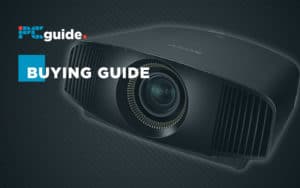
Best Projector for Gaming in 2023
As shown with our product selections above, there are a number of projectors that are stand out when gaming. However, the one that provides a truly all-round great experience while not breaking the bank is the BenQ TH671ST. It has impressive brightness and contrast as well as ultra-fast low input lag and microsecond DMD response, ensuring that your gaming will be as smooth as possible. On the other hand, if you want the best of the best and a gaming projector that’s next-gen ready, you can’t pass on the 4k capabilities of the Sony VLPVW675ES. It is far superior to pretty much all consumer targetted projectors on the market but it does come at an eye-watering price so its always worth weighing up that aspect.


